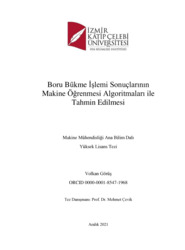Boru bükme işlemi sonuçlarının makine öğrenmesi algoritmaları ile tahmin edilmesi Predicting the results of the pipe bending process with machine learning algorithms
-
Eser Sahibi
Görüş, Volkan
- Tez Danışmanı Mehmet Çevik
-
Tür
Yüksek Lisans
- Yayın Tarihi 2021
-
Yayıncı
Fen Bilimleri Enstitüsü
- Tek Biçim Adres https://hdl.handle.net/11469/3121
-
Konu Başlıkları
Boru bükme
Yapay zeka
ÖZETBoru bükme işlemi sanayide, uzay-havacılık, otomotiv, inşaat, denizcilik, vb. birçok sektörde yoğun olarak kullanılmaktadır. Boru bükme işlemi manuel ve CNC kontrollü tezgâhlarda yapılmaktadır. Kullanılan malzemeye ve müşterinin isteği veya kullanım yerinin hassasiyetine göre çeşitli boru bükme yöntemleri kullanılmaktadır. Sanayide en çok kullanılan boru bükme yöntemleri
çekerek boru bükme yöntemi, sararak boru bükme yöntemi, basarak boru bükme yöntemi ve üç makaralı boru bükme yöntemidir. Boru bükme işleminde kullanılan borunun malzemesine, borunun dış çapına, et kalınlığına, bükme derecesine, bükme yarıçapına bağlı olarak farklı problemler oluşturmaktadır. Bu nedenlere bağlı olarak en çok karşılaşılan problemleri, borunun iç kısmında oluşan deformasyon (marullanma), borunun dış kısmında oluşan deformasyon (potlaşma), boru üzerinde oluşan izler, borunun çatlaması, borunun kırılması olarak sıralayabiliriz. Bu çalışmada boru büküm işlemleri sonucunda ortaya çıkan problemleri önceden tahmin edebilmek için makine öğrenme (yapay zekâ) algoritmaları kullanılmıştır. İlk önce sabit ve değişken değerler tanımlanmıştır. Sabitler malzemenin cinsi ve büküm yarıçapı olarak
değişkenler ise borunun dış çapı, borunun et kalınlığı, büküm açısı, malafanın büküm eksenine uzaklığı ve malafa çeşidi olarak belirlenmiştir. Sabit ve değişken değerlere ait 150 adet deneyi içeren deneysel veri tablosu hazırlanmıştır. Deneysel veri tablosunda sonuçları verilen deneyler Mutlu Metal A.Ş.' deki CNC boru bükme makinesinde gerçekleştirilmiştir. Deneysel veri tablosundaki testler yapıldıktan sonra sonuçları listelenmiştir. Bu sonuçlar makine öğrenme algoritmasının ham verileri olarak kullanılmıştır. Altı farklı makine öğrenme algoritması kullanılarak sonuçlar tahmin edilmeye çalışılmıştır. Bu çalışma sayesinde boru bükme işleminde ilk seferde doğru üretim yapılması sağlanarak, ön seri üretim maliyeti önemli ölçüde azaltılabilecektir.ABSTRACTPipe bending is extensively used in aerospace, automotive, construction, marine, and in many other industries. Pipe bending is done manually and on CNC controlled workbenches. Various pipe bending methods are used according to the material used and the customer's request or the sensitivity of the place of use. The most commonly used pipe bending methods in the industry are
tube bending by pulling method, tube bending by wrapping method, tube bending by pressing method and three-roller tube bending method. Pipe bending creates different problems depending on the material of the pipe used, the outer diameter of the pipe, the wall thickness, the degree of bending, and the bending radius. Depending on these reasons, we can list the most common problems as deformation (surface warping) in the inside of the pipe, deformation on the outside of the pipe, traces on the pipe, cracking of the pipe, breakage of the pipe. In this study, machine learning (artificial intelligence) algorithms are used to predict the problems that arise as a result of pipe bending operations. First, constant and variable values are defined. Constants values are material type and bend radius
variable values are the outer diameter of the pipe, the wall thickness of the pipe, the bending angle, the distance of the mandrel from the bending axis and the mandrel type. An experimental data table containing 150 experiments was prepared based on constant and variable values. The experiments, the results of which are given in the experimental data table, were carried out on the CNC pipe bending machine of Mutlu Metal A.Ş. The results are listed after the tests in the experimental data table are performed. These results were used as the raw data of the machine learning algorithm. The results were tried to be estimated using six different machine learning algorithms. By means of this study, it will be possible to reduce the pre-series production cost significantly by ensuring the correct production at the first time in the pipe bending process
-
Koleksiyonlar
ENSTİTÜLER
FEN BİLİMLERİ ENSTİTÜSÜ

 Tam Metin
Tam Metin

